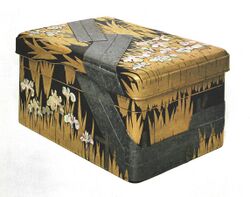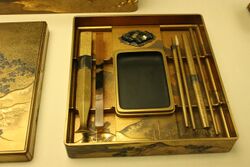Engineering:Suzuri-bako
Suzuri-bako (硯箱; "inkstone box") are a type of Japan ese writing box. The boxes are traditionally made of lacquered wood and are used to hold writing implements.[1] Historically, the boxes were associated with calligraphy, and as such they were made using high-quality materials designed to safeguard porcelain inkstones (suzuri) from damage.[2]
History
The first suzuri-bako were developed in 9th-century Japan.[2] At the time, calligraphy was an integral part of Japanese society. In order for a writer to produce a high-quality calligraphy script, a set of precise tools was needed. The most important of these tools was the inkstone, which was required to hold and transfer ink onto a writer's brush.[2] Ink sticks, water droppers, and a small knife were also part of a calligrapher's set.[2] Suzuri-bako were designed to ensure that the various tools a calligrapher needed were properly organized and protected.[1] Due to the insoluble nature of resin-based lacquer, the contents of the writing box were relatively safe from moisture.[3] Inside of the square or rectangular boxes rested a number of different trays and holders, the layout of which differed from period to period.[2] Early boxes were large enough to accommodate both the writer's implements and papers, while later boxes only housed tools. A second type of box, the ryōshibako, were used in later periods to house completed papers.[2]
Suzuri-bako became more elaborate as over time. While early period boxes are often decorated with solid red lacquer, more modern boxes are decorated in any number of ways.[2] From the Muromachi period onward, many writing boxes have been decorated with images from Japan's great works of literature.[2] Kōdaiji Temple in Kyoto became associated with a style of Suzuri-bako decoration that featured asymmetrical patterns and autumn grasses. In terms of lacquerware, black, brown, and gold are the most common colors seen in more modern suzuri-bako. During the Edo period many dowries included a suzuri-bako.[2] Advancements in technology and manufacturing processes during the Meiji period resulted in a development of a number of new box shapes and sizes.[2] The craft declined after the wide scale replacement of calligraphy, though the boxes are still produced in small numbers.
Gallery
17th-century suzuri-bako depicting a dragon
References
- ↑ 1.0 1.1 "Writing box (suzuribako)". Asian Art Museum: Education. http://education.asianart.org/explore-resources/artwork/writing-box-suzuribako.
- ↑ 2.0 2.1 2.2 2.3 2.4 2.5 2.6 2.7 2.8 2.9 Bincsik, Monika. "Japanese Writing Boxes: Essay: Heilbrunn Timeline of Art History: The Metropolitan Museum of Art". https://www.metmuseum.org/toah/hd/jabo/hd_jabo.htm.
- ↑ Cassal, U. (1959). "Japanese Art Lacquers". Monumenta Nipponica, 15 (1/2), 1–11. doi:10.2307/2382829
External links
 |









